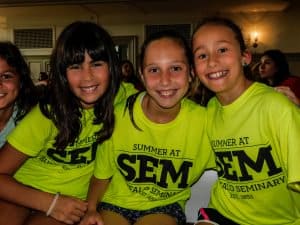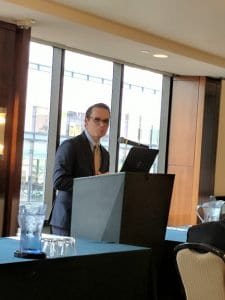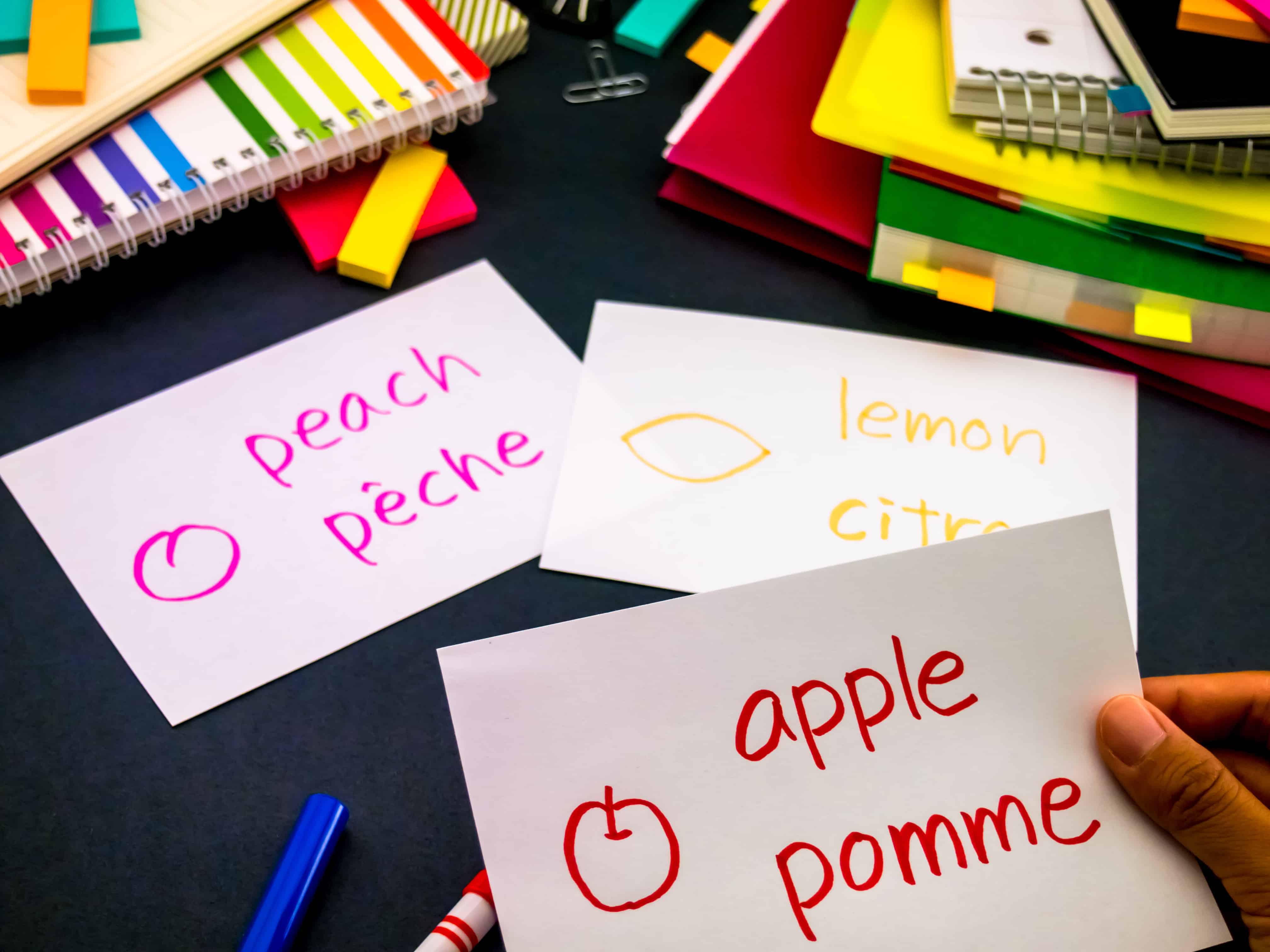
 Tom Beeman suggests strategies to maintain continuity between secondary and post-secondary Spanish education that may help to boost college language enrollments in all languages
Tom Beeman suggests strategies to maintain continuity between secondary and post-secondary Spanish education that may help to boost college language enrollments in all languages
The term education gap often refers to socioeconomic factors such as race, income, or gender, and perhaps even issues such as equity and access to education come to mind. But what about linguistic abilities or even the differences between the way the same subject matter is taught in high schools versus colleges? Unfortunately, there seems to be a gap between these different levels of education, especially when it comes to the teaching of world languages. To solve this dilemma, it is important to learn about trends in both secondary and post-secondary language teaching, be open to input from those in the field, and begin to come up with ideas for possible solutions. Though this article focuses on the teaching of Spanish, many of these same issues and solutions could easily be applied to other languages.
The first step toward solving any problem is to reflect on current practices and perspectives. Here, that means looking at the current trends in language education. Technology has come a long way since I first started teaching 15 years ago. I remember my credential program instructors talking about the importance of technology, but back then technology meant the use of overhead projectors, audiovisual equipment for using supplemental materials from the textbook publishers, and finding time to schedule a session for the class in the computer lab. Now, even Web 2.0 is starting to become outdated with the rapid pace of technical advancements. Who needs a paper dictionary when you can download an app on your smartphone? Students can use social media such as Twitter or Snapchat to incorporate language use into everyday life. This is also a great opportunity to make the world a smaller place by interacting with native speakers in the community and around the world.
Another key issue is differentiated instruction. While the idea of multiple approaches to teaching to meet different learning styles is not new, there is now the need to shift from learning styles to learning populations. It is common practice to see many schools, even at the high school level, offer Spanish for Spanish Speakers courses, and anyone who remotely speaks Spanish at home is put on these courses. However, there is a need to differentiate between native speakers and heritage language learners. Native speakers are more like true bilingual students—that is, students who have the skilled use of both languages and can function as two monolingual people in the same being. However, according to Wiley (2001), heritage language learners are those who have some proficiency in a community or ancestral language. These speakers have communicative competence in the language but lack the academic competence that a native speaker possesses. For many of them, learning is more about making a connection to family and culture through language than it is about academic linguistic acquisition. While colleges and universities recognize this distinction and can differentiate instruction accordingly, many high schools still need work in this area.
I remember, back in 1990, my history teacher telling me that someday students would not come to a physical school but would be able to learn from the teacher on television or via a computer. I thought he was crazy. I never would have guessed that two decades later I would be one of those teachers. As an online teacher at both the high school and college levels, I see the growing demand for online education, but there are three tiers to this type of learning and, sadly, I do not see much communication and/or collaboration between the three groups. I teach at an online high school that is 100% distance education, but students still meet live with the teacher throughout the week. The college course I teach is completely asynchronous—there is no live interaction between the instructor and the students unless they drop by during office hours. However, these courses are often taught by adjunct faculty who are not required to hold office hours, and if they do, they are most likely virtual. Then, there is blended learning, in which students attend a traditional brick-and-mortar school and are either given supplemental instruction and assignments online or combine some days meeting face to face and some days online only.
While all three are valuable in meeting the needs of our students and do have some unique issues, there are underlying issues that are same across all three tiers, and it is my belief that if the groups were to start interacting with each other, they would be able to work together to find solutions to everyone’s benefit. While the approaches may be different between secondary and post-secondary, there are some additional areas where there is common ground. According to Bell (2005), along with colleagues with whom I have spoken, the following are areas in which both institutions are in agreement: communicative and interactive approaches to language learning, courses based on the ACTFL World-Readiness Standards (the five “C”s), increase in authentic culture, and the recruitment of qualified teachers for less commonly taught languages. Having examined the trends in world language education, I see it is critical that those on the front lines in the classroom have a voice as well. I sent out a survey to Spanish teachers across the country (both secondary and post- secondary) on a variety of topics having to do with language education and will now share their thoughts.
Q1. Are university professors preparing prospective teachers well?
A1. 65% No
The feeling was that there is a lack of knowledge of second-language acquisition theories and pedagogy. It is possible for teachers to obtain their degrees without having enrolled in a theoretical course on language acquisition. It is even possible to major in something other than Spanish and still teach, as long as the candidate can pass a standardized test demonstrating language competency. Respondents also felt that some professors lacked the ability to speak the language well and that degree programs were too literature based. But the biggest concern was that post-secondary educators are not required to complete any kind of teacher preparation program similar to what is required for K–12 teachers. There are brilliant minds in the field who have graduate and doctorate degrees and are experts in their content fields. But being an expert in one’s field does not automatically translate to having the ability to teach it.
Q2. Are university professors too disconnected from the high school educational setting?
A2. 82% Yes
I recently attended a conference where representatives from 32 states were gathered to discuss and promote language education. There were members from all levels of education, industry, politics, and so on. Some of the consistent comments that were made were that there is a need to bridge the gap between high school and college because colleges are not prepared to teach the students who are coming from today’s language courses. This was also reflected in the survey, in which respondents felt that professors are not keeping up with current trends in language education. Respondents felt the disconnect was largely due to a lack of communication and understanding between the two levels. High school teachers have more hours of required instruction per week and have other duties that require evening and weekend hours, such as sporting events, dances, and parent-teacher meetings. Additionally, there was a desire for college professors to attend workshops led by high school teachers just like high school teachers attend workshops led by college professors.
Q3. Are high school teachers preparing students well enough for college?
A3. 58% No
Respondents felt it was “hit and miss” due to lack of professional development by high school teachers. With some states such as California no longer requiring professional development hours, combined with a lack of funding to pay for courses and conferences, teachers are reluctant to give up their free time to improve practice. They also felt that teachers were preparing students “to the best of their ability” because of pressure on retention and pass rates, which sometimes resulted in “encouragement” to provide extra credit for students for non-language items (such as providing tissues or bringing cans in for a school-wide food drive).i There is lack of support due to the number of nonteaching activities required. But the lack of support does not necessarily mean a lack of willingness or desire to support the world language teacher. Even the most outstanding administrators are limited in the support they are able to offer if they have not experienced learning a language other than their first or have not been trained in language acquisition theories and pedagogy. The other issue where respondents felt high school teachers had difficulty preparing students was the “native speaker” model. Textbooks are designed to teach Spanish so that students are able to communicate with educated, middle-income or higher speakers of Castellano in Madrid. There is no teaching or accepting of varieties of Spanish from other dialects, total rejection of “nonstandard” varieties of Spanish such as Spanglish, and bigotry toward the nonnative variety of Spanish, just as there is with English (Valdés, 1999).
Q4. Do secondary education teachers follow advances in applied linguistics research?
A4. 76% No
As mentioned in the discussion of the previous question, lack of time is the big issue. High school teachers are on campus five days a week and can often be found on campus after contract hours because they know that is the only time they are available outside of class to support students seeking additional help. Add in the aforementioned lack of funding for professional development, the erosion of the requirement for professional development hours to renew their credentials, and the lack of language studies requirements for graduation, and the prevailing opinion among teachers is if the state does not care about professional development, why should they?
From a pedagogical perspective, not all teachers have studied applied linguistics, so having never studied the principles of it, they are not likely to study advances. Those teachers who do graduate with a linguistics concentration in their majors are more likely to have had their studies focus on generative linguistics, because they need to understand grammatical theories, since that is the core of what has been traditionally taught in the classroom. I feel it would be a tremendous asset if teachers were to learn about how socioeconomic status and other applied linguistic theories factor in to language learning with native, heritage-language, and nonnative Spanish speakers.
Q5. What suggestions would you make to teacher preparation programs to help prepare prospective Spanish teachers?
As important as it was to give teachers an opportunity to examine where issues like those are causing a gap, I felt it was equally important to have them propose solutions. For secondary teachers, it was suggested that additional preteaching observation time be incorporated into teacher preparation programs. For post-secondary teachers, it was suggested a certificate program in teaching of 18 hours be created. For both levels, it was suggested that degree programs ensure instruction on second-language acquisition theories and a focus on both language and culture as part of their course of study.
Q6. What unique challenges do you see to teaching Spanish online and how would you recommend teacher education programs and the professional development community better serve this population of educators?
Distance-education teachers are often overlooked in the conversation when it comes to the professional development community because not a lot is known about us outside of our online community. This is evident in respondents’ comments, as there is a lack of mention of incorporation of online teaching in state/national standards.ii Therefore, teachers feel that they must take it upon themselves to align learning outcomes with the standards in a way that meets the unique needs of this student population.
While there are other problems, such as difficulties with technology and lack of face-to-face student/teacher interaction, the biggest challenge to distance-education teaching is the lack of available resources for teacher preparation.iii Lack of face-to-face interaction can make it easier for students to use translation websites and other tools that violate schools’ academic integrity policies. In fact, a recent article was published on how artificial intelligence is becoming so advanced that it is increasingly difficult to determine the difference between human translation and computer translation (Alang, 2018). While there are courses in teacher education that are offered online, there are no courses in how to teach in a distance-education setting, and there is no training for university students taking distance-education courses.iv Even for veteran teachers, it is a challenge, and there needs to be a period of adjustment when switching from bricks-and-mortar to an online environment. When it comes to parental support, there is an increased difficulty because, unless a student is self-motivated, parents need to be even more hands-on than usual, as it is easy for students to avoid logging in and completing assignments without parental monitoring.
Some other discrepancies based on my own observations and on informal conversations with colleagues over the course of my career are as follows: use of target language in the classroom varies;v high schools use varied methods of instruction, whereas colleges are primarily lecture based; colleges do not offer any of seal of biliteracy, and not every state offers them for high school students either; schools, districts, and teacher preparation programs may lack support programs for distance-education teachers, possibly including some districts that sponsor online charter schools; and state content standards and frameworks may be outdated or nonexistent.
Solutions
Some possible solutions to these problems would be to align teacher preparation programs to K–12 teaching requirements (there can be a disconnect between what the university requires of the student teacher and what the school requires of him or her in the classroom); offer additional methodology courses, such as those for distance-education teachers; have some kind of collaboration (maybe a brown bag forum) between language teachers of every level to discuss everyone’s needs; and allow release time for secondary teachers similar to a sabbatical. I think this last point is a valid one that should be examined further, as it would not only solve the teacher burnout/retention problem but also help solve the issue of lack of professional development. Imagine if a high school teacher had a paid year off (or even just a semester) to work on research, attend conferences, give seminars, and so on. That teacher would have the chance to keep up with current practices in the field, and he or she could bridge this gap by having this time to meet with college and university professors. While there are discrepancies among language teachers, we all have one goal in mind: to help expand our students’ horizons through language learning. If we as a language community can avoid pointing the finger at one side or another, set our differences aside, and come to the table, we could not only strengthen our programs but expand them as well.
Bibliography
Alang, Naveet. (March 16, 2018). “Microsoft’s Translation Treason.” The Week. http://theweek.com/articles/760984/microsofts-translation-treason.
Bell, Teresa R. (2005). “Behaviors and Attitudes of Effective Foreign Language Teachers: Results of a Questionnaire Study.” Foreign Language Annals 3(2), 259–270.
Collins, L., and Muñoz, C. (2016). “The Foreign Language Classroom: Current Perspectives and Future Considerations.” Modern Language Journal 100 (Supplement 2016), 133–147.
Russell, V. (2017). Email communication.
Stevenson, H. W., and Nerison-Low, R. (2000). To Sum It Up: Case Studies of Education in Germany, Japan, and the United States. National Institute on Student Achievement, Curriculum, and Assessment Office of Educational Research and Improvement, U.S. Department of Education.
Valdés, G. (1999). “Nonnative English Speakers: Language Bigotry in English Mainstream Classrooms.” ADLF Bulletin 31(1), 43–48.
Wiley, T. (2001). “On Defining Heritage Languages and Their Speakers.” In J. K. Peyton, D. A. Ranard, and S. McGinnis (eds.), Heritage Languages in America: Preserving a National Resource, 29–36.
i This same problem is also occurring in post-secondary courses, where pass rates are tied in with tenure and retention due to increased pressure to develop major-oriented students.
ii As of this writing, although ACTFL does have a Distance Education Special Interest Group, there is no mention of online learning and teaching in the World Readiness Standards.
iii Difficulties with technology could refer to nonfunctioning programs or teachers who are not proficient enough with technology to be able to use the various platforms that come with online teaching.
iv This could be especially problematic for re-entry students and for those entering the profession for the first time.
v One of ACTFL’s core practices is that teachers should use the target language 90% of the time, but high schools predominately use English as the primary method of instruction.
Tom Beeman is a High School Spanish Teacher at the California Virtual Academies, Adjunct Spanish Instructor at Taft College, California Language Teachers’ Association (CLTA) Advocacy Chair, CLTA 2017 Outstanding Language Teacher Award recipient, and co-author of the book “Voces; Latino Students on Life in the United States”


 This summer, Buffalo Seminary (SEM), one of the oldest girls’ schools in the U.S., has opened its beautiful student residences for international students who want to learn English, have fun, and practice safe independence.
This summer, Buffalo Seminary (SEM), one of the oldest girls’ schools in the U.S., has opened its beautiful student residences for international students who want to learn English, have fun, and practice safe independence.
 A new study reveals that bilinguals and trained musicians utilize fewer resources in their brains while doing tasks involving memory. This means that it’s easier for them to do so. As their brains use less effort to perform tasks, researchers infer that their musical and bilingual brains may protect them from the onset of cognitive decline later in life.
A new study reveals that bilinguals and trained musicians utilize fewer resources in their brains while doing tasks involving memory. This means that it’s easier for them to do so. As their brains use less effort to perform tasks, researchers infer that their musical and bilingual brains may protect them from the onset of cognitive decline later in life.

 A new tax deal set by the Danish government will place stronger conditions for entry to social welfare programs and payments for foreign citizens. The tax cut, which amounts to 5 billion kroner, aim to deliver 1,850-3,150 kroner to each Danish taxpayer, which is much less than the government’s original initiative of between 5,000-26,700 a year. Along with a job deduction, current employment deduction, and pension scheme deduction for Danish taxpayers, the cuts aim to fiance part of the revenue from foreigners seeking language classes among other government resources.
A new tax deal set by the Danish government will place stronger conditions for entry to social welfare programs and payments for foreign citizens. The tax cut, which amounts to 5 billion kroner, aim to deliver 1,850-3,150 kroner to each Danish taxpayer, which is much less than the government’s original initiative of between 5,000-26,700 a year. Along with a job deduction, current employment deduction, and pension scheme deduction for Danish taxpayers, the cuts aim to fiance part of the revenue from foreigners seeking language classes among other government resources. British Accreditation Council (BAC) CEO Paul Fear explains the rationale behind the organization’s move into the accreditation of English language providers (ELPs) worldwide
British Accreditation Council (BAC) CEO Paul Fear explains the rationale behind the organization’s move into the accreditation of English language providers (ELPs) worldwide Fabrice Jaumont is convinced that dual-language education should be the norm rather than the exception
Fabrice Jaumont is convinced that dual-language education should be the norm rather than the exception Bilingual education means different things to different people. Some want access to English and the equal opportunity it provides. Others want to sustain their heritage and utilize bilingual education as a tool to do so. Others are interested in the benefits of bilingualism for cognitive development. Others are interested in the acquisition of a second, third, or fourth language because of the professional opportunities and advantages it will yield. Ultimately, these perspectives share the same goal: to create a multilingual society with greater access to languages and cultures.
Bilingual education means different things to different people. Some want access to English and the equal opportunity it provides. Others want to sustain their heritage and utilize bilingual education as a tool to do so. Others are interested in the benefits of bilingualism for cognitive development. Others are interested in the acquisition of a second, third, or fourth language because of the professional opportunities and advantages it will yield. Ultimately, these perspectives share the same goal: to create a multilingual society with greater access to languages and cultures.

 After decades of research, University of Kansas researcher William Keel believes it was Henry Ford, not Kaiser Bill, who was responsible for the decline of the distinctive German dialects spoken by immigrants and their descendants in five Kansas and Missouri settlements during the 20th century.
After decades of research, University of Kansas researcher William Keel believes it was Henry Ford, not Kaiser Bill, who was responsible for the decline of the distinctive German dialects spoken by immigrants and their descendants in five Kansas and Missouri settlements during the 20th century. Although infants do appreciate the coos of their parents, they seem to prefer to hear sounds from other babies, according to a new Canadian study.
Although infants do appreciate the coos of their parents, they seem to prefer to hear sounds from other babies, according to a new Canadian study.